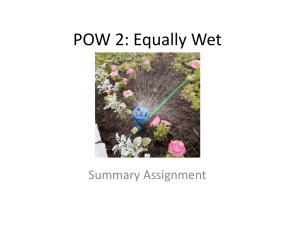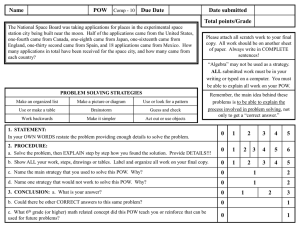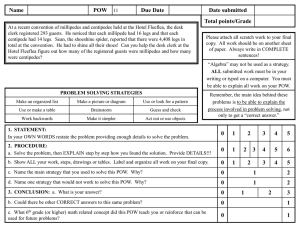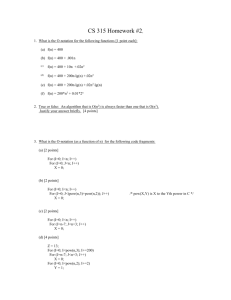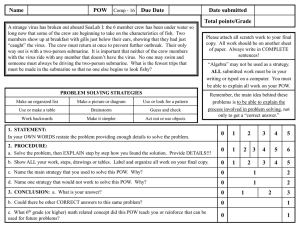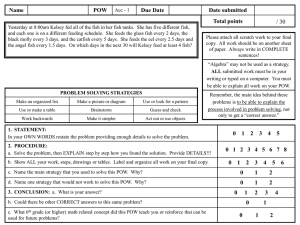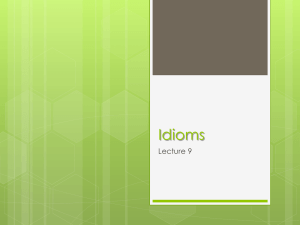POW#1Model
advertisement
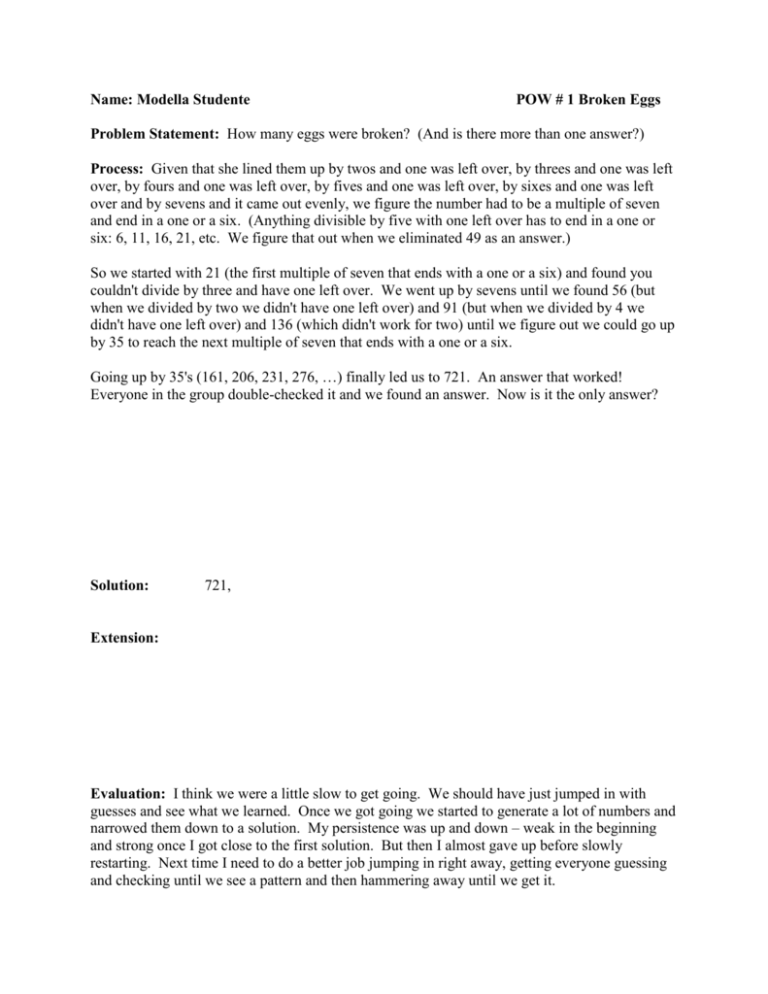
Name: Modella Studente POW # 1 Broken Eggs Problem Statement: How many eggs were broken? (And is there more than one answer?) Process: Given that she lined them up by twos and one was left over, by threes and one was left over, by fours and one was left over, by fives and one was left over, by sixes and one was left over and by sevens and it came out evenly, we figure the number had to be a multiple of seven and end in a one or a six. (Anything divisible by five with one left over has to end in a one or six: 6, 11, 16, 21, etc. We figure that out when we eliminated 49 as an answer.) So we started with 21 (the first multiple of seven that ends with a one or a six) and found you couldn't divide by three and have one left over. We went up by sevens until we found 56 (but when we divided by two we didn't have one left over) and 91 (but when we divided by 4 we didn't have one left over) and 136 (which didn't work for two) until we figure out we could go up by 35 to reach the next multiple of seven that ends with a one or a six. Going up by 35's (161, 206, 231, 276, …) finally led us to 721. An answer that worked! Everyone in the group double-checked it and we found an answer. Now is it the only answer? We realized that the answer had to be odd (because any number divided by two with one left over is odd) so we could go up by 70's. So we started a new list (791, 861, 931, 1001…) until we found 1141 worked. Nikki the had the brilliant idea to check this pattern and see if the next answer would be 420 more (1141 + 420 = 1561) and it did. So did 1981 (1561 + 420) and 2401 (1981 + 420). My question is why doesn't 721- 420 (301) work? I checked it and it worked! How did we miss that? Solution: 301 and 721, 1141, 1561, 1981, 2401. If I'm the insurance agent I only pay for the 301 and tell her to get a better cart because the solutions will keep getting larger and larger Extension: I was wondering why 420 was the magic number so I played around with it and discovered they all (2, 3, 4, 5, 6 & 7) all go into it. But if I multiple them all together I get 5040. Why isn't that the gap? Again by playing around I realized that if 4 goes into a number than 2 does also. Same with 3 and 6, but since 6 is even and taken care of by the 2, I can just multiply 3 • 4 • 5 • 7 which equals 420. Voila! So in theory if the egg woman said she stacked them by twos and had one left over, Threes with one left over, fours with one left over – same with fives and sixes, but didn't get even sevens, the gap between the solutions would be 60 (3 * 4 * 5). I checked it and it was correct. Solutions: 61, 121, 181… Evaluation: I think we were a little slow to get going. We should have just jumped in with guesses and see what we learned. Once we got going we started to generate a lot of numbers and narrowed them down to a solution. My persistence was up and down – weak in the beginning and strong once I got close to the first solution. But then I almost gave up before slowly restarting. Next time I need to do a better job jumping in right away, getting everyone guessing and checking until we see a pattern and then hammering away until we get it. POW Rubric A - Overall presentation of POW is coherent and well presented. Problem and all assumptions are clearly and accurately stated. Explanation of process is detailed and includes sketches, graphs, charts and other pertinent information. Process is logical and systematic. Unsuccessful strategies are included and what was learned from these strategies is explained. The solution is clearly stated and accurate. The extension is creative and accurately applies the problem principles. The evaluation thoroughly and accurately evaluates the student’s effort, persistence and strategies. B - Overall presentation and each section is better than a C paper, but is not as well-presented, organized, coherent or thorough as an A. C - Overall presentation of POW is organized and readable. Problem and all assumptions are accurately stated. Explanation of process is coherent and includes some sketches, graphs, charts or other pertinent information. Process is logical and systematic. Some unsuccessful strategies are included and what was learned from these strategies is explained. The solution is accurate. The extension accurately applies some of the problem principles, but copies the original too closely or contains some misapplication or misunderstanding of the problem principles. The evaluation briefly evaluates the student’s effort, persistence and strategies. D - Overall presentation approaches a C in some ways but includes too many F characteristics, incomplete or missing sections. F - Overall presentation of POW is disorganized or unreadable. Problem is incompletely or inaccurately stated. Assumptions are not stated. Explanation of process is not coherent or missing parts. Sketches, graphs, charts or other pertinent information is missing. Process is not logical or systematic or complete. Unsuccessful strategies are not included and what was learned from these strategies is not explained. The solution is not accurate. The extension is missing, incomplete or inaccurately applies the problem principles. The evaluation is missing or does not evaluate the student’s effort, persistence and strategies.
